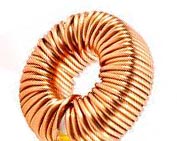A ferrite toroid is a product that is able to provide high magnetic efficiency, and this is due to the fact that no air can get through the cross-sectional area. The product is uniform. Ferrite toroids come in many different styles: size, materials, and more. A ferrite toroid has permeability the ranges from 5,000 J material to 10,000 W materials. Ferrite cores allow for amazing possibilities in toroids, and so the rest of this article will discuss what ferrite is.
 Simply put, ferrite is a certain kind of ceramic compound, which is made up of iron oxide. The iron oxide is mixed with other metallic elements. Ferrite isn’t inherently magnetic but it can easily be magnetized. They work well when being attached to magnets because ferrite has nonconductive properties.
Simply put, ferrite is a certain kind of ceramic compound, which is made up of iron oxide. The iron oxide is mixed with other metallic elements. Ferrite isn’t inherently magnetic but it can easily be magnetized. They work well when being attached to magnets because ferrite has nonconductive properties.
Ferrite is broken up into two main categories: Hard and Soft. The main distinction between hard and soft is the amount of coercivity. Coercivity can be defined as how hard or easily ferromagnetic material will become demagnetize. Hard ferrites don’t lose magnetism like soft ferrite does. There are times when soft ferrite is needed, and there are times where hard ferrite is needed.
Ferrite made from manganese-zinc or nickel-zinc is considered a soft ferrite. These materials have a low coercivity. The materials are able so switch directions without substantial hysteresis losses. They are well equipped to mitigate eddy currents that would otherwise happen in the core. In this case, the ferrite can help prevent energy loss. Most commonly soft ferrite is used when working with RF transformers and inductors. They help with switch-mode power supplies, as well as helping AM radios (loopstick antennas).
Hard ferrites can also be called permanent ferrite magnets. Unlike soft ferrites, these ferrites have high coercivity. It is rather difficult for hard ferrite to lose its magnetism, even when you are purposefully trying to do so. These materials also provide users with extremely high magnetic permeability. It is much more common to find hard ferrite in the home. This includes a home refrigerator. Hard ferrite is usually made from strontium or barium. In some cases this even include cobalt.
Toroids
Knowing the differences between ferrite will allow you to have a deeper understanding of the toroids you acquire and use. There is a lot to consider when in the market for toroids. Don’t think that you have to make the journey alone. Toroid and bobbin companies can give you full breakdowns of different types of toroids.
Related Reading
- The Top Four Reasons to Use Toroidal Transformers and Custom Coil Winding
When compared to similarly powered transformers, toroids are commonly the best option. There are many reasons why toroidal transformers are a better option than a conventional transformer. - Popular Types of Magnetic Core Used in Toroidal Transformers
- Do Toroids Work in Industrial Applications

